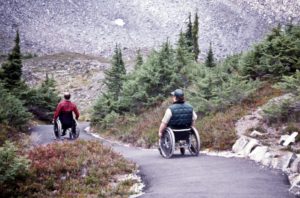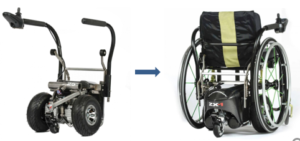Author: Sharon Jang | Reviewer: Jaimie Borisoff | Published: 15 May 2020 | Updated: ~
Wheelchair propulsion assist devices are pieces of equipment that can facilitate the use of a manual wheelchair. This page provides an overview of the different options available. SCIRE Community is not affiliated with and does not endorse any of the specific products mentioned on this page.
Key Points
- Propulsion assist devices are technologies that attach to your manual wheelchair to facilitate propulsion
- There is limited research on the effectiveness of these devices, but they are clinically well-accepted with perceived benefits associated with their use
- There are options for both powered and non-powered propulsion assist devices, depending on your needs
- Propulsion assist devices can be either front frame-mounted, replace your rear wheels, or rear frame-mounted
- Propulsion assist devices are rapidly developing and changing; specific products in this article may no longer be available or unavailable in your area

An example of a front-mounted propulsion assist device.1
Propulsion assist devices are pieces of equipment that can be attached to a manual wheelchair to facilitate the ease of using a wheelchair, or expand the capabilities of a manual wheelchair. These devices generally work by reducing the amount of effort required by the user to move their wheelchair. Use of these devices may help individuals go up hills, reduce the amount of force required to start moving the wheelchair, or travel over difficult terrain such as grass. Propulsion assist devices are normally added onto the front or back of the chair frame, but also sometimes replace the rear wheels. These devices can be further split up into two categories: powered and non-powered.
As technology is rapidly progressing, novel devices are being frequently released. The development of multiple devices to fill a niche market has resulted in some products becoming unavailable in certain areas, or leaving the market altogether. The quick changes and developments in this area make conducting research on propulsion assist devices difficult. Currently, there is limited research on the use of propulsion assist devices for manual wheelchair users and most of the research is focussed on the devices that replace the rear wheels.

Using a propulsion assist device can be beneficial to manual wheelchair users. The man on the left is using a powered add-on.2
Power assist devices may be purchased by individuals with or without a prescription. Some indications for propulsion assist device use are limited strength in the upper body, or for those that are at a higher risk of an injury or pain to the arms and/or shoulders. These devices may improve participation in the community by enabling increased travel distance and access to more difficult environments.
In two studies (weak evidence), users of propulsion assist devices have reported benefits including:
- Less strain on the cardiovascular and respiratory systems; this results in reduced overall feelings of fatigue.
- Being able to go further with less effort (improved propulsion efficiency). This may help prevent overuse injuries.
- Increased distance you are able to travel before feeling tired.
- Travelling up and down hills.
- Improved ability to travel on non-paved roads (e.g., grass, gravel, dirt), which increases the variety of spaces a wheelchair user may access.
Although there is limited research on propulsion assist devices, Pushrim Activated Power-Assist Wheelchairs (PAPAW) are the most researched device. Evidence has suggested that using PAPAWs have multiple benefits. One study provided moderate evidence for the use of PAPAWs to help individuals with SCI who have shoulder pain to propel their wheelchair further distances. The participants in this study also required less energy to wheel, and perceived that wheeling was easier with the use of PAPAWs. Other (weak) evidence has also shown that using a PAPAW may reduce the frequency of arm/shoulder injuries and the amount of energy required. Additional (weak) evidence suggests that individuals with tetraplegia using PAPAWs have improved ability to manoeuvre through a variety of textured surfaces and to complete activities of daily living.
Although propulsion assist devices can facilitate the use of a manual wheelchair, there are also some risks associated with their use. While this is not an exhaustive list, risks include:
Increased risk of wheelchair damage
Most manual wheelchair frames may not have been designed to withstand the different forces applied by propulsion assist devices. This may lead to premature wear and tear, or possible breakage, on some parts of the wheelchair, such as the footplate. Sudden breakage during use may lead to injury of the wheelchair user.

Using a propulsion assist device may increase the risk of tipping when going up or down hills.3
Decreased stability
The addition of a propulsion assist device either in front or behind the wheelchair may alter the center of gravity on the wheelchair. This may result in greater instability, increasing the risks of tipping backwards when going up and down steep hills. Forward stability may be compromised as well and induce tipping (e.g. when moving down at the bottom of a curb cut).
Greater impact forces when encountering an obstacle
Propulsion assist devices, especially motorized ones, allow wheelchair users to travel at a greater speed. However, hitting obstacles such as a rock or a curb in your wheelchair at a higher speed can result in greater forces, which may lead to a decrease in stability and increase the risk of falls.
Potential lateral stability issues
Propulsion assist devices that attach to the front pose a risk of tipping sideways. Particularly when travelling at higher speeds, sudden turns can result in tipping over.
Prior to obtaining a propulsion assist device, you should always consult your health professional. That said, some factors to consider when deciding whether to invest in an add-on include the following factors:
Upper limb function
Upper limb function is required to use these devices. For example, the individual may be responsible for attaching/detaching the device to the wheelchair, and some degree of hand function is needed for operation. Some products do have adapted controls for use by individuals with limited hand function.
Terrain
The device should facilitate the transportation of the user over surfaces that they frequently travel on, or wish to travel on. Some terrain considerations include indoor travel, outdoor travel, uneven surfaces, soft terrains e.g. grass, and hills.
Transfer ability

It is important to take into consideration how a device may impact transferring in and out of a wheelchair. Will it make transfers more difficult?
Transport
![]()
If a car is used for transportation, consideration of the weight of the propulsion device should be considered. Will the weight of the propulsion assist device and the wheelchair be manageable to lift into a car? Will the propulsion assist device fit into the car?
Weight
Is the device light enough for the user to remove by themselves? Will the weight make manual propulsion more difficult when not in use (e.g. if battery is drained before end of travel)?
Interaction with wheelchair
Propulsion assist devices require a certain part of a wheelchair to connect to, which may vary between types of wheelchair (e.g., rigid vs folding wheelchairs) and types of add-on. How the device mounts to a wheelchair should be considered, including the user’s capability for performing the attachment/detachment. Additional consideration may be needed if the device is going to be used between different wheelchairs.
Addressing casters
Casters help provide stability to a wheelchair, but become a limiting factor when a wheelchair user wishes to travel off a smooth even surface. There are some devices that connect to the front of the wheelchair via the foot plate and lift up the front caster wheels. This allows the wheelchair user to travel over uneven surfaces easier, such as dirt paths, sand, and gravel. An example of this kind of device is a FreeWheel.
Mechanical advantage
 There are some devices that facilitate pushing by amplifying your efforts (a mechanical advantage) using gears or levers. Using a device with a mechanical advantage will allow you to go further with a given push. One example of a device that provides mechanical advantage is a lever-propelled wheelchair. There are some lever devices that can be connected to your wheel (others require replacement of the rear wheels) that allow the user to propel by pushing the lever forward. Using a lever has two purported benefits: 1) using a longer lever to propel a wheelchair requires less force, and 2) using a lever enables a more favorable movement pattern of the hands, wrists, and shoulder. Together these may reduce the risk of injury. An example of this device is the NuDrive.
There are some devices that facilitate pushing by amplifying your efforts (a mechanical advantage) using gears or levers. Using a device with a mechanical advantage will allow you to go further with a given push. One example of a device that provides mechanical advantage is a lever-propelled wheelchair. There are some lever devices that can be connected to your wheel (others require replacement of the rear wheels) that allow the user to propel by pushing the lever forward. Using a lever has two purported benefits: 1) using a longer lever to propel a wheelchair requires less force, and 2) using a lever enables a more favorable movement pattern of the hands, wrists, and shoulder. Together these may reduce the risk of injury. An example of this device is the NuDrive.
Pushrim-Activated Power-Assist Wheelchairs (PAPAWs)
 A PAPAW is a manual wheelchair with motorized rear wheels. The wheels are powered by a battery, which is attached to the back of the wheelchair. This type of wheelchair is controlled by normal pushing movements using the pushrims. PAPAWs assist individuals with limited strength or arm function by amplifying the force applied to the wheels. Each push on the pushrim by the user is sensed and proportionally amplified to increase the force to continue the forward movement. This also occurs for braking and turning (e.g., the wheels would detect a backwards force and apply a stronger braking force). This allows for users to go further with a given push, or to brake more efficiently with less force. When desired, the power assist function can be turned off. One limitation of using PAPAWs is the significantly increased weight of the wheelchair, which is especially noticeable when turned off. Another limitation is that the pushrims are damaged more easily, as this is where the sensors are located. Some examples of PAPAWs include the Alber E-motion and the Quickie Xtender.
A PAPAW is a manual wheelchair with motorized rear wheels. The wheels are powered by a battery, which is attached to the back of the wheelchair. This type of wheelchair is controlled by normal pushing movements using the pushrims. PAPAWs assist individuals with limited strength or arm function by amplifying the force applied to the wheels. Each push on the pushrim by the user is sensed and proportionally amplified to increase the force to continue the forward movement. This also occurs for braking and turning (e.g., the wheels would detect a backwards force and apply a stronger braking force). This allows for users to go further with a given push, or to brake more efficiently with less force. When desired, the power assist function can be turned off. One limitation of using PAPAWs is the significantly increased weight of the wheelchair, which is especially noticeable when turned off. Another limitation is that the pushrims are damaged more easily, as this is where the sensors are located. Some examples of PAPAWs include the Alber E-motion and the Quickie Xtender.
Front mounted systems
These systems attach to the front of the wheelchair frame and typically lift up the front casters. Non–powered versions exist which are propelled via cranks and chains similar to handcycles. Most often powered, these devices are able to turn manual wheelchairs into a three-wheeled “scooter”. Front mounted systems are usually controlled with a throttle controller, which removes the need to manually propel the wheelchair. They are also able to reach significantly higher speeds in comparison to other power add-ons. A disadvantage to front mounted systems is that they add length to the wheelchair, which may impact the ability to move around indoors. In addition, the devices can be fairly heavy (e.g., the typical Batec system is 25 kg), and little to no customizations can be made. Examples of front mounted systems include the Rio Mobility Firefly, Triride, Klaxon, and Batec.
Rear mounted systems
 Rear mounted propulsion device generally connect to the bar underneath the wheelchair seat (i.e., the camber tube). These devices can power the wheelchair so that no manual propulsion is required, although turning and braking still require constant user control. Currently, there are two models commercially available that are light, compact, and easily attached: the SmartDrive and the Smoov. The SmartDrive is controlled with a wristband worn by the user. A double tap of the wristband (or similar accelerometer-sensed motion of the hand/arm when tapping the wheel or other surface) will activate the motor and begin accelerating the wheelchair. Another tap sets the speed, while the next double tap will stop the motor. Gripping on the handrim is usually still needed to slow down and stop the chair. Users are not required to propel the wheelchair once it is in motion; they are only required to steer. Good reaction time is required to operate the device; a learning curve is involved when first using the device. The Smoov operates via a frame mounted control knob to set the desired speed. Starting and stopping the motor is accomplished through tapping the knob. Turning, slowing, and stopping are similar to the SmartDrive operation.
Rear mounted propulsion device generally connect to the bar underneath the wheelchair seat (i.e., the camber tube). These devices can power the wheelchair so that no manual propulsion is required, although turning and braking still require constant user control. Currently, there are two models commercially available that are light, compact, and easily attached: the SmartDrive and the Smoov. The SmartDrive is controlled with a wristband worn by the user. A double tap of the wristband (or similar accelerometer-sensed motion of the hand/arm when tapping the wheel or other surface) will activate the motor and begin accelerating the wheelchair. Another tap sets the speed, while the next double tap will stop the motor. Gripping on the handrim is usually still needed to slow down and stop the chair. Users are not required to propel the wheelchair once it is in motion; they are only required to steer. Good reaction time is required to operate the device; a learning curve is involved when first using the device. The Smoov operates via a frame mounted control knob to set the desired speed. Starting and stopping the motor is accomplished through tapping the knob. Turning, slowing, and stopping are similar to the SmartDrive operation.
 Other rear-mounted systems, such as the Spinergy ZX-1, convert manual wheelchairs into a power wheelchair. The user backs up into the device, which connects to the wheelchair with a push of the button. This add-on lifts up the rear wheels of the wheelchair, converting it into a power wheelchair that is controlled with a joystick.
Other rear-mounted systems, such as the Spinergy ZX-1, convert manual wheelchairs into a power wheelchair. The user backs up into the device, which connects to the wheelchair with a push of the button. This add-on lifts up the rear wheels of the wheelchair, converting it into a power wheelchair that is controlled with a joystick.
The use of propulsion assist devices has the potential to protect your arms and shoulders from pain and overuse injuries, and allow you to travel further with less energy and more various terrain. Many different kinds of technologies are being rapidly developed and introduced to the market to facilitate manual wheelchair use. Thus, the world of powered propulsion assist devices is ever changing. Due to this factor, the devices discussed in this article may change, or may no longer be available for purchase.
Any reference to a specific product does not constitute or imply an endorsement by SCIRE Community. Professional advice should be sought before making any health care and treatment decisions.
For a review of how we assess evidence at SCIRE Community and advice on making decisions, please see SCIRE Community Evidence.
SCIRE Community. “Powered Mobility Devices”. Available from: https://community.scireproject.com/topic/powered-mobility/
SCIRE Community. “Manual Wheelchairs”. Available from: https://community.scireproject.com/topic/manual-wheelchairs/
SCIRE Community. “Wheeled mobility video series”. Available from: https://community.scireproject.com/videos/wheeled-mobility/
SCIRE Community. “Wheelchair Add-ons”. Available from: https://community.scireproject.com/resources/products-and-devices/
Titus L, Moir S, Casalino A, McIntyre A, Connolly S, Mortenson B, Guilbalt L, Miles S, Trenholm K, Benton B, Regan M. (2016). Wheeled Mobility and Seating Equipment Following Spinal Cord Injury. In Eng JJ, Teasell RW, Miller WC, Wolfe DL, Townson AF, Hsieh JTC, Connolly SJ, Loh E, McIntyre A, editors. Spinal Cord Injury Rehabilitation Evidence. Version 6.0: p 1-178.
Available from: https://scireproject.com/evidence/rehabilitation-evidence/wheeled-mobility-and-seating-equipment
Evidence for “What are wheelchair propulsion devices” is based on:
Choukou, M.-A., Best, K. L., Potvin-Gilbert, M., Routhier, F., Lettre, J., Gamache, S., … Gagnon, D. (2019). Scoping review of propelling aids for manual wheelchairs. Assistive Technology, 0(00), 1–15. Retrieved from https://doi.org/10.1080/10400435.2019.1595789
Evidence for “What are the benefits of using a propulsion assist device” is based on:
Morgado Ramirez, D. Z., & Holloway, C. (2017). “But, I Don’t Want/Need a Power Wheelchair.” Proceedings of the 19th International ACM SIGACCESS Conference on Computers and Accessibility – ASSETS ’17, 120–129. Retrieved from http://dl.acm.org/citation.cfm?doid=3132525.3132529
Evidence for “What are the risks of using a propulsion assist device” is based on:
Medicines and healthcare products regulator agency (2004). Guidance on the Stability of Wheelchairs, (March). Retrieved from http://www.unece.org/fileadmin/DAM/trans/doc/2004/wp29grsg/GRSG-ig-access-03-10.pdf
Ogilvie, C. (2019). Finite Element Analysis of a Wheelchair when Used with a Front-Attached Mobility Add-On by (November).
Evidence for “What should I consider when contemplating propulsion assist device” is based on:
Agency for clinical innovation (2019). Prescribing manual wheelchair with propulsion assist devices. Retrieved from: https://www.aci.health.nsw.gov.au/networks/spinal-cord-injury/spinal-seating/module-9/prescribing-manual-wheelchair-with-propulsion-assist-devices
Evidence for “What are the options for powered propulsion assist device” is based on:
Choukou, M.-A., Best, K. L., Potvin-Gilbert, M., Routhier, F., Lettre, J., Gamache, S., … Gagnon, D. (2019). Scoping review of propelling aids for manual wheelchairs. Assistive Technology, 0(00), 1–15. Retrieved from https://doi.org/10.1080/10400435.2019.1595789
Corfman TA, Cooper RA, Boninger ML, Koontz AM, Fitzgerald SG. Range of motion and stroke frequency differences between manual wheelchair propulsion and pushrim-activated power-assisted wheelchair propulsion. J Spinal Cord Med 2003;26(2):135-40
Nash MS, Koppens D, van Haaren M, Sherman AL, Lippiatt JP, Lewis JE. Power-assisted wheels ease energy costs and perceptual responses to wheelchair propulsion in persons with shoulder pain and spinal cord injury. Arch Phys Med Rehabil 2008;89:2080-5.
Image credits
- Batec Handbike. © SCIRE Community Team
- Moving in the community. © SCIRE Community Team
- Men in wheelchairs at heather lake, Mt. Baker Snoqualmie National Forest. © U.S. Forest Service – Pacific Northwest Region.
- Hand © Sandra. CC BY 3.0
- Mountain © iconcheese. CC BY 3.0
- Transfer © romzicon. CC BY 3.0
- Car © Priyanka, IN. CC BY 3.0
- Scales © Made, AU. CC BY 3.0
- Wheelchair © Satawat Anukul, TH. CC BY 3.0
- FreeWheel Wheelchair Attachment © FreeWheel 2020
- Stanley handling NuDrive Air © NuDrive Air 2020
- Alber E-Motion M25 © Manston mobility 2018
- Firefly Electric Attachable Handcycle for Wheelchair © Rio Mobility 2020
- Smart Drive © MAX Mobility, LLC 2019
- Spinergy ZX-1 © Spinergy 2020








